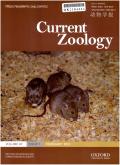影响殖民地狮鹫产仔扩散的空间、社会和环境因素
IF 2
2区 生物学
Q2 ZOOLOGY
引用次数: 0
摘要
产地扩散是个体健康以及种群生存能力、结构和遗传特性的关键特征。然而,由于难以在适当的时空尺度上对个体进行监测,对于大型长寿物种来说,存在着明显的信息空白。在此,我们利用对西班牙大量雏鸟标记个体的长期(30 年)监测,研究了个体特征、社会和环境特征如何影响狮鹫(Gyps fulvus)的产地扩散决策。我们的研究结果表明,雌雄狮鹫都有很强的亲缘性,有些个体会在它们出生的同一悬崖甚至同一巢穴中繁殖。同种密度对个体参数的影响调节了这种集群倾向,并强调了同种吸引和食物供应变化的重要性,它们可能影响了集群规模的扩大和新区域的殖民化。尽管还需要对更小的群落和更孤立的种群核心进行进一步研究,但我们的研究结果凸显了对长寿物种进行长期研究的重要性,以了解决定其种群动态的因素及其与人类活动的关系,并利用保护标准来预测和管理人类活动的影响。本文章由计算机程序翻译,如有差异,请以英文原文为准。
Spatial, social and environmental factors influencing natal dispersal in the colonial griffon vulture
Natal dispersal is a critical trait for individual fitness and the viability, structure and genetic identity of populations. However, there is a pronounced information gap for large and long-lived species due to the difficulty of monitoring individuals at appropriate spatio-temporal scales. Here we study how individual traits and social and environmental characteristics influence natal dispersal decisions of griffon vultures (Gyps fulvus) using long-term (30 years) monitoring of a large number of individuals marked as nestlings in Spain. Our results show a strong philopatry in both sexes, with some individuals recruiting as breeders on the same cliffs, and even the same nests, where they were born. This philopatric tendency was modulated by the effect of conspecific density on individual parameters, and emphasize the importance of conspecific attraction and changes in food availability that may have influenced the increment in colony size and the colonization of new areas. Although further research is needed considering smaller colonies and more isolated population nuclei, our results highlight the importance of long-term studies on long-lived species to understand the factors that determine their population dynamics and their relationship with anthropogenic activities, whose effects should be predicted and managed using conservation criteria.
求助全文
通过发布文献求助,成功后即可免费获取论文全文。
去求助
来源期刊

Current Zoology
Agricultural and Biological Sciences-Animal Science and Zoology
CiteScore
3.20
自引率
9.10%
发文量
111
审稿时长
6 weeks
期刊介绍:
About the Journal
Current Zoology (formerly Acta Zoologica Sinica, founded in 1935) is an open access, bimonthly, peer-reviewed international journal of zoology. It publishes review articles and research papers in the fields of ecology, evolution and behaviour.
Current Zoology is sponsored by Institute of Zoology, Chinese Academy of Sciences, along with the China Zoological Society.
 求助内容:
求助内容: 应助结果提醒方式:
应助结果提醒方式:


